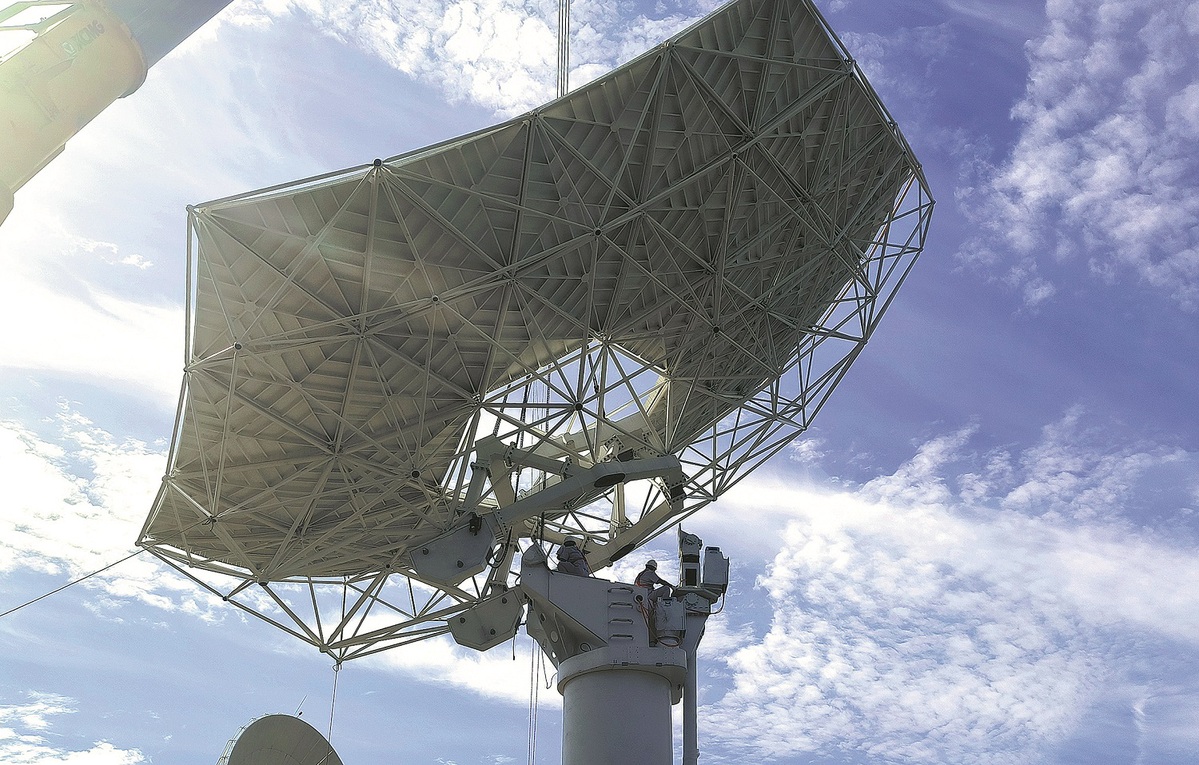




The first middle-frequency dish of the Square Kilometer Array radio telescope, the world's biggest astronomy network, is being assembled in Shijiazhuang, Hebei province, on Wednesday. ZHAO LEI/CHINA DAILY
Square Kilometer Array project involves China, the UK, Australia and others
The first middle-frequency dish of the Square Kilometer Array radio telescope, the world's biggest astronomy observation network and an international mega-science project, has begun to be assembled in Shijiazhuang, Hebei province.
The Square Kilometer Array is an ambitious scientific endeavor involving several nations including China, the United Kingdom and Australia. It is not a single radio telescope, but a collection of various types of antennae called an array, and is spread over long distances with up to one square kilometer in total collecting surface area, the equivalent of 140 soccer fields.
At a brief ceremony in a northwestern suburb of Shijiazhuang on Wednesday morning, the main reflector of the first Square Kilometer Array middle-frequency dish, officially abbreviated as SKA-Mid, was lifted by a heavy-duty crane and placed onto the dish's pedestal.
Engineers then spent several hours connecting the two colossal components on the site.
Most of the parts for the large parabolic dish, including the main reflector, servo devices and support arm, were designed and built by the 54th Research Institute of China Electronics Technology Group Corp, located in Shijiazhuang, which is the major Chinese contractor in the SKA project.
Du Biao, chief designer of the dish at the institute, told China Daily in an exclusive interview after the ceremony that in the coming days, engineers will mount the remaining parts on the dish like the sub-reflector and start fine-tuning the entire dish to ensure its operational stability and accuracy.
"If everything goes according to plan, the fine-tuning process will take about three to four weeks. After that, scientists will start a monthlong trial run gaining experience and data that will help a lot in the manufacturing and tests of following dishes," he said.
The operation of SKA-Mid requires extremely high accuracy in terms of beam deformation, pointing precision, electromagnetic shielding and electromagnetic compatibility, according to Du.
"Its design and production are very challenging for us. To solve these demanding technical issues, our researchers and engineers made all-out efforts to develop world-class technologies for its servo systems, dynamic simulation, and calibration and testing methods," he noted.
Yang Jinrong, a structural engineer of the dish, said the main reflector is made up of 66 individual panels and each of them needs to be fine-tuned with sub-millimeter precision to ensure a smooth collecting surface.
"The average surface accuracy on the dish boasts an outstanding level of between 0.03 and 0.1 of a millimeter, which is less than the width of two human hairs combined," he explained.
Production for the first batch of 64 SKA-Mid dishes, including the one involved in Wednesday's ceremony, has begun at the Shijiazhuang institute and they will be delivered to the SKA Observatory, an intergovernmental organization based in Manchester in the United Kingdom. They will be installed in the Karoo region of South Africa.
Another major section of the SKA project, the low-frequency antennas, or SKA-Low, will be located in the remote Murchison area in Western Australia.
Eight other African nations including Botswana, Ghana and Kenya will also house some of the system's facilities.
All of the sites have been chosen for scientific and technical reasons, including radio quietness.
William Garnier, director of communications at the SKA Observatory, said at the ceremony on Wednesday that the fact the contract for the first 64 SKA-Mid dishes was conferred to the CETC 54th Research Institute "is a recognition of the institute's expertise in complex radio systems as well as the great work they have delivered during the design phase of the (SKA) telescope".
Upon its scheduled completion in the coming decade, SKA will be the largest and most advanced astronomy system on Earth and is expected to give unprecedentedly detailed insight into the history of the universe. It will also enable scientists to better understand the nature of gravity, explore the origins of life and cosmic magnetic fields, as well as search for extraterrestrial life.
The super network's ultra large collecting area will give it 50 times the sensitivity and 10,000 times the survey speed of the best current-day telescopes — the Karl G. Jansky Very Large Array in New Mexico in the United States.
The full array will produce data at a rate more than 100 times the global internet traffic, according to Chinese scientists involved in the program. They said the system will be so sensitive that, metaphorically speaking, it will be able to pick up conversations from an aircraft 50 light-years away.
It is China's second-largest international science collaboration after the International Thermonuclear Experimental Reactor, the world's largest nuclear fusion experiment.




